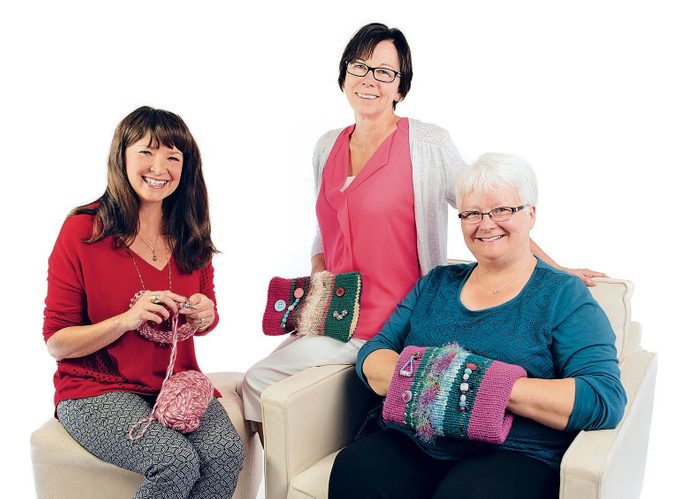Great Canadians: Therapeutic Hand Muffs
Cindy Pandke, Kim Reid and Noelle Tangredi’s cozy creations soothe agitated dementia patients.
 When Cindy Pandke, 56, took a knitting class with her son in January 2015 – his Christmas gift to her – she hadn’t picked up needles or yarn in more than 40 years. But she immediately remembered what she’d learned from her mother while growing up in St. Thomas, Ont.; after casting a few stitches, she was hooked. Pandke brought her supplies to St. Joseph’s Health Care in London, Ont., where she’s employed as an e-learning specialist, and set up a tutorial for her co-workers, Noelle Tangredi, 51, and Kim Reid, 59.
When Cindy Pandke, 56, took a knitting class with her son in January 2015 – his Christmas gift to her – she hadn’t picked up needles or yarn in more than 40 years. But she immediately remembered what she’d learned from her mother while growing up in St. Thomas, Ont.; after casting a few stitches, she was hooked. Pandke brought her supplies to St. Joseph’s Health Care in London, Ont., where she’s employed as an e-learning specialist, and set up a tutorial for her co-workers, Noelle Tangredi, 51, and Kim Reid, 59.
The three women wanted their new lunchtime activity to be more than a hobby – they hoped it could benefit others. At first, they tackled small projects: dishcloths for a women’s shelter and catnip pouches for an animal rescue. A couple of months after the tutorials began, Tangredi broached the idea of a hand muff – tube shaped and made with yarns of different textures – designed to provide tactile stimulation. The colleagues soon realized the fuzzy products might be able to help people in their very own workplace: the e-learning department shares a building with the Mount Hope Centre for Long Term Care, where many patients have Alzheimer’s.
Tangredi understands well how a restless mind can lead to physical agitation – especially fretful hands. Her mother was diagnosed with Alzheimer’s in 1993 and passed away a decade later; at age 79. A favourite self-soothing mechanism had been to pet a stuffed cat.
One of the first recipients of a hand muff was a woman prone to outbursts of yelling and pulling at her clothes. The handicraft “immediately calmed her,” Tangredi says. It has since become part of the patient’s regular treatment, written into her file so caregivers keep it close by.
Since the initial prototype was completed in April 2015, the group has donated 525 of its “therapeutic hand muffs for dementia” to local organizations that work with patients suffering from the condition. The founders operate out of their lunchroom, which is also where they store tackle boxes full of beads and buttons. Muffs are crafted on-site during breaks or arrive nearly completed by other volunteers – mostly family and friends.
Next, it’s time for decorations, or what the women call “doodads”: shiny trinkets, beads on strings, buttons and tassels – objects to occupy fidgety hands that tend to grab at things incessantly. Finally, the knitwear goes through quality control to ensure the embellishments are firmly secured before the muff is sewn up.
In later stages of dementia, patients become increasingly confused, which can cause them to lash out: “When someone is verbally or physically upset, this can be a result of anxiety, mood disorders or fear,” says Dr. Sheri-Lynn Kane. A geriatrician at St. Joseph’s, Kane donated buttons to the cause after seeing the muffs’ therapeutic benefits. “I think of them like worry beads, or any kind of repetitive activity that can be soothing,” she says.
Also lending a hand are local knitting circles, including one at the Little Red Mitten in St. Thomas, where Pandke and her son took their class, and a group in a nearby retirement home. Custom orders now come in for children with autism – muffs are calming and help them self-regulate their moods.
The Christmas after Pandke took that knitting class, her father-in-law suffered a stroke at the age of 101. Seeing him grab at his clothes and the bedding in his hospital room, Pandke knew what to do. “He still uses his muff at night when he’s agitated,” she says.



